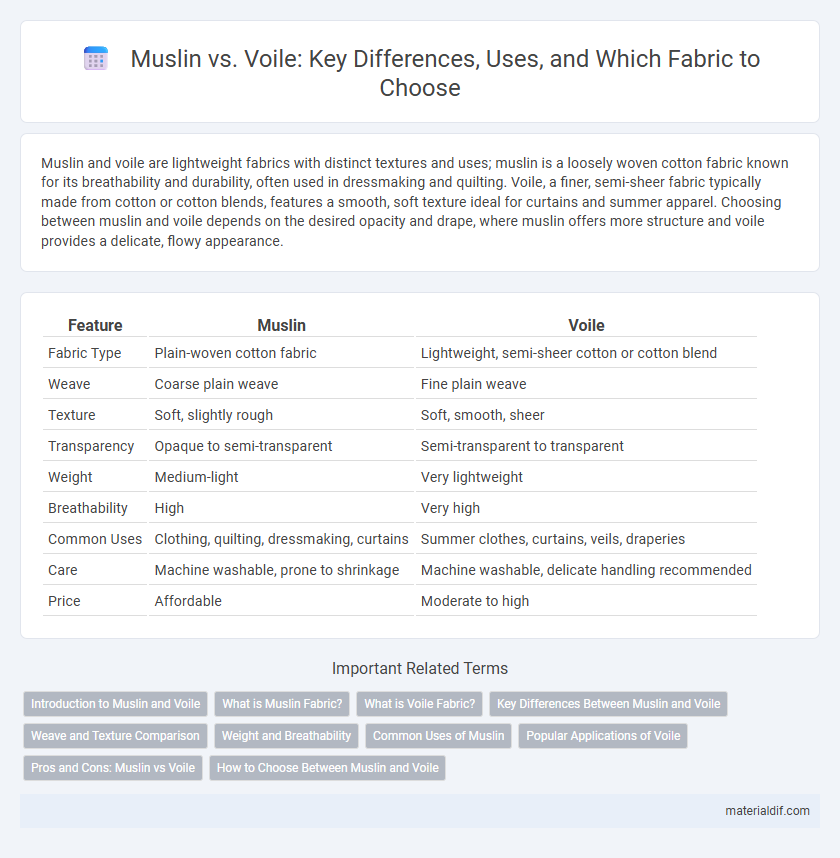Muslin and voile are lightweight fabrics with distinct textures and uses; muslin is a loosely woven cotton fabric known for its breathability and durability, often used in dressmaking and quilting. Voile, a finer, semi-sheer fabric typically made from cotton or cotton blends, features a smooth, soft texture ideal for curtains and summer apparel. Choosing between muslin and voile depends on the desired opacity and drape, where muslin offers more structure and voile provides a delicate, flowy appearance.
Table of Comparison
| Feature | Muslin | Voile |
|---|---|---|
| Fabric Type | Plain-woven cotton fabric | Lightweight, semi-sheer cotton or cotton blend |
| Weave | Coarse plain weave | Fine plain weave |
| Texture | Soft, slightly rough | Soft, smooth, sheer |
| Transparency | Opaque to semi-transparent | Semi-transparent to transparent |
| Weight | Medium-light | Very lightweight |
| Breathability | High | Very high |
| Common Uses | Clothing, quilting, dressmaking, curtains | Summer clothes, curtains, veils, draperies |
| Care | Machine washable, prone to shrinkage | Machine washable, delicate handling recommended |
| Price | Affordable | Moderate to high |
Introduction to Muslin and Voile
Muslin is a lightweight, breathable cotton fabric known for its plain weave and versatility in dressmaking, quilting, and home decor. Voile is a soft, sheer fabric made from cotton or cotton blends, featuring a finely woven, lightweight texture ideal for summer clothing and curtains. Both fabrics offer airy comfort but differ in transparency and texture, with muslin being more opaque and voile providing a delicate, semi-transparent finish.
What is Muslin Fabric?
Muslin fabric is a lightweight, plain-woven cotton material known for its soft texture and breathability, making it ideal for apparel, curtains, and baby products. It originates from the city of Mosul in Iraq and is distinguished by its open weave, allowing air to circulate freely. Muslin is often favored for its versatility, affordability, and natural fibers, contrasting with fabrics like voile in terms of weight and transparency.
What is Voile Fabric?
Voile fabric is a lightweight, semi-sheer cotton or cotton-blend textile characterized by its soft texture and delicate drape. Often used for curtains, summer clothing, and lightweight dresses, voile offers breathability and a smooth finish with a slightly crisp hand feel. Compared to muslin, voile has a tighter weave and finer yarns, resulting in a smoother surface and more elegant appearance.
Key Differences Between Muslin and Voile
Muslin is a loosely woven cotton fabric known for its coarse texture and durability, often used in dressmaking, quilting, and upholstery, while voile is a lightweight, semi-sheer fabric made from cotton or cotton blends with a smooth, soft texture ideal for curtains and summer garments. Muslin typically has a heavier weight and less transparency compared to voile, which features a more refined weave allowing greater light diffusion and breathability. The key differences lie in their weave density, texture, opacity, and common applications in fashion and home decor.
Weave and Texture Comparison
Muslin features a plain weave with a soft, slightly coarse texture that offers moderate breathability, making it ideal for lightweight garments and home textiles. Voile, woven with a balanced plain weave but tighter and finer threads, provides a smooth, sheer texture with higher transparency and a delicate drape. The looser weave of muslin results in a more open, matte finish, while voile's finer weave creates a crisp, semi-glossy surface.
Weight and Breathability
Muslin is a lightweight, loosely woven cotton fabric known for its superior breathability, making it ideal for warm-weather clothing and baby wraps. Voile, while also lightweight, has a tighter weave that offers a slightly denser texture and less breathability compared to muslin, providing a soft drape suitable for curtains and summer apparel. Both fabrics are breathable, but muslin's lower weight and open weave enhance airflow more effectively than voile.
Common Uses of Muslin
Muslin is commonly used in garment construction as a lightweight, breathable fabric for prototype sewing and pattern testing due to its affordability and ease of handling. It is also popular in home decor for curtains, linings, and dust covers because of its plain weave and versatility. Muslin's soft texture makes it a preferred choice for baby products, swaddling cloths, and lightweight apparel.
Popular Applications of Voile
Voile fabric, characterized by its lightweight and sheer texture, is widely used in curtains, summer clothing, and decorative overlays due to its breathability and soft drape. Popular applications of voile include elegant window treatments that allow natural light while maintaining privacy, as well as flowing summer dresses and blouses that offer comfort in warm climates. Its fine weave and smooth finish make voile a preferred choice for delicate apparel and home decor where a light, airy feel is desired.
Pros and Cons: Muslin vs Voile
Muslin features a coarser weave, making it more breathable and durable but prone to wrinkling and less smooth compared to voile. Voile offers a finer, sheer texture ideal for lightweight drapes and garments, providing an elegant drape yet requiring careful handling due to its delicate nature. Muslin suits casual, functional uses, while voile excels in decorative, airy applications.
How to Choose Between Muslin and Voile
Choosing between muslin and voile depends on the desired fabric weight, texture, and transparency for your project. Muslin offers a coarser weave and a sturdier feel, ideal for quilting or dress prototypes, while voile provides a lightweight, sheer, and soft texture suited for summer garments and curtains. Consider breathability and drape, with voile delivering a delicate fluidity and muslin providing more structure and opacity.
Muslin vs Voile Infographic

 materialdif.com
materialdif.com